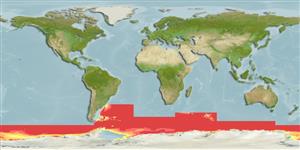>
Myctophiformes (Lanternfishes) >
Myctophidae (Lanternfishes) > Gymnoscopelinae
Etymology: Gymnoscopelus: Greek, gymnos = naked + Greek, skopelos, a lantern fish (Ref. 45335).
Eponymy: John Treadwell Nichols (1883–1958) was an American ichthyologist, mammalogist and ornithologist. [...] (Ref. 128868), visit book page.
More on author: Gilbert.
Environment: milieu / climate zone / profondeur / distribution range
Écologie
marin bathypélagique; océanodrome (Ref. 51243); profondeur 300 - ? m (Ref. 4066). Deep-water; 35°S - 78°S
Generally ranges between Antarctica and 35°S (off Argentina), 47°S (Falkland Current region), and 47°-49°S (between 45°E and 71°E). Adults occur only in high latitudes (South Orkneys, South Shetlands, Antarctic Peninsula); juveniles and adults in waters around South Georgia and central Scotia Sea.
Taille / Poids / Âge
Maturité: Lm ? range ? - ? cm
Max length : 19.1 cm TL mâle / non sexé; (Ref. 124149); poids max. publié: 47.10 g (Ref. 124149)
Description synthétique
Clés d'identification | Morphologie | Morphométrie
Épines dorsales (Total) : 0; Rayons mous dorsaux (Total) : 17 - 19; Épines anales: 0; Rayons mous anaux: 19 - 21.
Body shape (shape guide): elongated.
South of the Antarctic Polar Front, adults occur in upper 250 m of open ocean and over continental shelves and oceanic banks (spring-summer) during the day, migrating to 50- 100 m at night. Also mesopelagic (Ref. 4066). Feeds on euphausiids and euphausiid larvae, hyperiids, mysids, copepods, and amphipods.
Life cycle and mating behavior
Maturité | Reproduction | Frai | Œufs | Fécondité | Larves
Hulley, P.A., 1990. Myctophidae. p. 146-178. In O. Gon and P.C. Heemstra (eds.) Fishes of the Southern Ocean. J.L.B. Smith Institute of Ichthyology, Grahamstown, South Africa. (Ref. 5182)
Statut dans la liste rouge de l'IUCN (Ref. 130435: Version 2025-1)
Menace pour l'homme
Harmless
Utilisations par l'homme
Pêcheries: intérêt commercial mineur
Outils
Articles particuliers
Télécharger en XML
Sources Internet
Estimates based on models
Preferred temperature (Réf.
123201): 0 - 2.5, mean 0.9 °C (based on 696 cells).
Phylogenetic diversity index (Réf.
82804): PD
50 = 0.5039 [Uniqueness, from 0.5 = low to 2.0 = high].
Bayesian length-weight: a=0.00490 (0.00268 - 0.00897), b=3.11 (2.94 - 3.28), in cm total length, based on LWR estimates for this species & (Sub)family-body (Ref.
93245).
Niveau trophique (Réf.
69278): 3.4 ±0.3 se; based on diet studies.
Résilience (Réf.
120179): Milieu, temps minimum de doublement de population : 1,4 à 4,4 années (Preliminary K or Fecundity.).
Fishing Vulnerability (Ref.
59153): Low vulnerability (10 of 100).
🛈
Nutrients (Ref.
124155): Calcium = 65.7 [17.5, 183.0] mg/100g; Iron = 0.447 [0.164, 1.452] mg/100g; Protein = 16.3 [14.6, 18.1] %; Omega3 = 0.306 [0.102, 0.899] g/100g; Selenium = 15.7 [4.6, 49.4] μg/100g; VitaminA = 79.4 [9.7, 660.3] μg/100g; Zinc = 0.718 [0.362, 1.544] mg/100g (wet weight); based on
nutrient studies.
